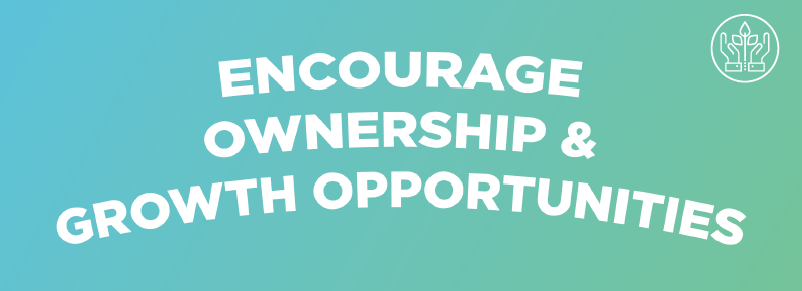How often do you see this scenario play out?
A new employee joins your team excited, motivated and full of new ideas. Then as the days turn into months, the energy and enthusiasm they walked through the door with plateaus, then inevitably plummets.
For many organisations, keeping staff engaged is an ongoing struggle. If your people are disconnected and aren’t engaged with the work they’re doing, how can you expect potential customers to get excited about your company?
Disengaged staff can also mean higher rates of absenteeism, lack of productivity, higher turnover, more room for human error, safety incidents, and much more.
If this sounds familiar, don’t panic. You are not alone. Many top HR leaders, CEOs and successful entrepreneurs have experienced these same frustrations and roadblocks. But many of them have also found ways to tackle this engagement head on.
Here at PageUp, we’ve compiled a list of ideas to help you reboot engagement in your organisation. We even approached some HR experts to contribute their own favourite engagement ideas.
Driving employee engagement could be one of the most important changes you make for your organisation that impacts your bottom line. In fact, companies with engaged employees perform 202% better than those with disengaged teams, research shows.
What drivers of engagement are you most keen to improve on over the next 12 months?
1. Identify the drivers of employee engagement
Despite what many people leaders may think, motivating employees takes far more than just remuneration and staff perks. The factors that drive engagement also can’t be applied with a broad stroke: they differ based on organisation, generation and role. So how can you identify the drivers of employee engagement in your organisation? Research shows us a few constants that have been proven to drive employee engagement across a range of generations, industries and demographics: these include leadership, learning and development opportunities, and a sense of meaning at work.
Some researchers, like the ones at HR Consultancy Penna, identify what they call a hierarchy of engagement: at the bottom are the basic needs of pay and benefits, next are development opportunities and the possibility for promotion. Leadership style plays an important role next: do leaders make an employee feel respected in their role? Finally, the overarching driver of engagement is an alignment of values and meaning: this is described by researchers as “a true sense of connection, a common purpose and a shared sense of meaning at work.”
Researchers at Culture Amp take their own view of what engages workers, but like the Penna researchers, they still place leadership near the apex of the engagement pyramid: in fact, Culture Amp puts leadership-related factors as three out of the top five drivers of employee engagement.
There is no hard and fast rule as to what drives employee engagement. It’s clear, however, that leadership, development opportunities and the chance to contribute to a meaningful vision are crucial to motivating employees, no matter the size or scope of an organisation.
2. Spend Time with Employees

“In 2011, The Society for Knowledge Economics released research from interviews with 5,661 employees in 77 Australian organisations. The findings demonstrated that the single biggest difference in leadership behaviour between high and low performing workplaces was the time spent by leaders with their team members.
In 2016, Google confirmed that through a careful review of their own company’s performance data, they could prove that frequent conversations between a leader and his or her team members was a leading indicator of a team’s high performance.
I believe that the time spent by a leader with his or her team members needs to be a mixture of formal time (in training, coaching, performance managing, etc.) and informal time (a coffee, lunch, general chat) etc.”
– Ross Clennett, High Performance Recruitment Coach
3. Good Leaders Are Meaning Makers

People (including employees) can be physically engaged (present with hands and feet) but not emotionally engaged (contributing with heart and soul).
Emotional commitment comes when employees find personal meaning from the work they do. Meaning need not be grandiose, and is inherently personal.
I find meaning from teaching and seeing students learn; Wendy (my wife) finds meaning from helping clients unravel emotional knots (psychologists). Others may find meaning in relationship, creativity, innovation, service, or reaching goals.
Good leaders are meaning makers who help each employee find his or her personal meaning through their work activities.
– Dave Ulrich, RBL Group, Author The Why of Work
4. Provide more than just a job
In the day-to-day grind, it can be easy to lose sight of why we do what we do. But for leaders looking to keep their employees engaged, providing more than just a nine-to-five is crucial. Of the 560 employees surveyed in Deloitte’s Talent 2020 report, one truth rang resoundingly clear: “Engage employees with meaningful work – or watch them walk out the door.”
It’s impossible to be engaged at work if the work you’re doing is not engaging. In Deloitte’s survey, 42% of respondents seeking new employment believed their current job did not make good use of their skills and abilities.
Similar surveys have yielded the same results: HR consulting company Penna conducted research into the role meaning plays in employee engagement. They found that employers who can unlock the secret of what provides meaning at work will find the key to employee engagement. Regardless of age, sex, region or length of time with their employer, 55% of respondents said that their motivation levels would increase if they were doing meaningful work. An additional 42% said they would be more loyal to their employer. Over one third said they would take more pride in their work and be willing to put in extra hours to ensure the job was done.
“In short, someone who has found a true sense of meaning at work and has therefore bought into the dream, is far less likely to leave than one who is simply paid a lot,” says Penna CEO Gary Browning.
“Put simply, organisations need to provide more than just a job.”
5. Establish a clear vision for the future
Employers looking to give employees a sense of meaning in their work must establish a clear vision for the future. In fact, 77% of employees surveyed in the Society for Human Resource Management’s annual Employee Job Satisfaction and Engagement survey said it was important to their job satisfaction and engagement to have a clear understanding of their organisation’s vision and mission.
The more clearly a leader communicates a vision that inspires employees, the more likely they will want to contribute to that vision.
To make sure everyone is on the same page with an organisation’s goals and visions from day one, HR practitioners can deploy onboarding software and elearning modules to communicate this vision at-scale to employees.
6. Measure Output Instead of Input

Claire Autruong from the todoist.com suggests moving away from monitoring and measuring success based on input, or hours worked, and focusing instead on measuring outcomes.
Does it really matter how many hours your employees do in the office? As long as the work they deliver is on time and to the standard agreed on, becoming outcomes-focused puts more emphasis on the end result.
This approach shifts the responsibility to employees, while empowering them to work in a way that fits their lifestyle and personal needs, thus driving engagement.
In fact, a Harvard Business Review study reported that companies who granted employees more choice in how they can work grow substantially while reducing their turnover.
Whether it suits people to finish early to pick-up the kids from school, or log back on late at night once the kids are in bed, letting people work when they’re most productive means you can focus on measuring the quality of work.
7. Be Proactive about Engagement

Have ever you hired someone who seemed lively, engaged and energetic in their job interview, only to lose their passionate attitude after a few months? Initial impressions may give way to a different story once an employee is settled into their role.
Instead of hiring employees to bring engagement to a role, proactively work with them to create roles that are engaging in the long-term. Todd Raphael of ERE media says that engagement is a two-way street:
“The best tip I can offer is to say that engagement and passion for a job are a two-way street. Hiring someone you’ve decided is loud or bubbly or outgoing or enthusiastic may provide a sugar high.
But if all the things that we all know provide engagement (pay, promotions, recognition, appreciation, interesting work, and so on) aren’t there, the passion is fleeting.
Expecting people to be engaged because the employer thinks they’re passionate types isn’t a long-term winner.”
– Todd Raphael, ERE Media
8. Rid Yourself of Process Driven Activities

Too often leaders get bogged down in process-driven managerial tasks that are not only monotonous, but time consuming. It’s why 75% of recruiters and hiring managers use applicant tracking or recruitment software to improve the hiring process.
If a function is repetitive, it lends itself to automation, so don’t be afraid to lean on technology. For instance, modern talent management technology can help you do everything from onboarding new starters, to keeping track of their ongoing development activities and professional goals.
It can free you up to spend more time engaging them in new opportunities and recommending the tools and learning they need to perform in their role.
– Marion Robinson, Global Head of Growth, PageUp
9. Tailor Communication Styles to Your Employees

“We read all the time about the ‘employee work experience’ and the need to customize that to each employee. That might be a challenge given the structure of your company. However, one thing that can be done is to sit down with each employee and truly learn how they like to be communicated with, then do it.
Adapt your style to their desired way of communication. This will be more effective than making them change their way.
If you truly want to customize their experience, you have to work at it. Find out how they like to learn and then structure their opportunities to learn around that style.
Seeing you adapt to their ways should increase their engagement because you have shown that you listened to what they said.”
– Mike Haberman, Omega HR Solutions
10. Make sure your leaders follow through on their promises
It’s no surprise that the actions of senior leadership have a direct impact on employee engagement. As the arbiters of change, leaders play a crucial role in creating meaning for your people. Because of this, it’s crucial that team leaders follow through on their promises: any feedback should be met with actioned, tangible change.
Conduct a 360 degree feedback process to get a sounding board for the pain points in your organisation, then develop a plan to action these changes. Employees will be judging their supervisors on what they do, not what they say, in response to their feedback.
Once you’ve gained an insight into what makes your employees tick, you need to have the resources and desire to act on these results. As HR consultant Gary Browning observes, “If you ask and don’t act you create more damage than if you don’t ask at all.”
11. Don’t ignore the truth: analyse your current approaches
Your existing workforce tells an important story about how effective your current talent management approaches are. Take a hard look at your employee turnover figures: retention is a litmus test for whether your employees feel engaged in their work. Any churn rate greater than 10% suggests a problem in your internal practices. Consider conducting an employee engagement survey as soon as possible to find out where you’re going wrong, and how you can improve your approaches.
12. Don’t have exit meetings – have ‘stay’ meetings
Rather than farewelling disengaged employees that have decided to jump ship, have ‘stay’ meetings before a goodbye is necessary.
Often, organisations meet with employees after they’ve announced their intention to leave. Before it gets this far, take an example from McDonald’s, who have ‘stay’ meetings to reduce the need for ‘exit’ interviews.
A stay meeting allows employers to measure an employee’s job satisfaction and engagement on a regular basis, feeling out the pain points and positives of their role. This can help reduce employee turnover rates and address people issues before it’s too late.
13. Respect employees
It may seem simple, but acknowledging and treating each employee with respect is one of the most meaningful things leaders can do to boost engagement. That doesn’t mean showering employees with constant praise and platitudes, but rather making employees feel valued and included in your organisation.
“Employees don’t automatically become engaged when you give them more praise, thanks, or any other type of acknowledgment. But, employees can quickly become disengaged if they feel like they’re invisible,” says entrepreneur Mike Kappel.
A recent SHRM survey found that 67% of employees surveyed rated respectful treatment of all employees at all levels as one of the most important drivers of engagement and satisfaction in their workplace. This study found that “By fostering a workplace environment that emphasizes communication, respect for others and collaboration among workers at all levels, HR professionals can expect higher levels of engagement from their employees.”
14. Lead by example
Engaging employees is as much about giving them meaningful work as it is about creating an environment where they experience engagement on a daily basis.
If the managers in your organisation aren’t passionate about their people, or aren’t engaged in their own role, it’s going to be hard for any employee reporting to them to remain engaged. Higher-ups should lead by example and bring the same passion and energy to their roles as they expect from their employees.

Empower Learning & Development
15. Provide ongoing opportunities for development
An employee’s development shouldn’t stop after they’ve been trained in their role. Employees need to constantly be challenged and upskilled in the workplace to keep them engaged.
This development doesn’t have to take the role of prescriptive training. Embrace a holistic approach to professional development – from attending conferences to meetups and hackathons, let employees hone their skills in the way they learn best. Instead of offering rigid learning opportunities, the key is to provide employees with the tools and opportunities for self-directed development.

16. Establish leadership pipelines
Establishing clear leadership pipelines shows employees you’re invested in their development and in their future with the company. Succession plans make employees feel like they are headed somewhere, which is crucial to keeping them engaged in their role. In Deloitte’s Talent 2020 series, which surveyed over 500 employees across the globe, 37% of employees changing roles cited a lack of career progress as their top reason for leaving the company.
If your workplace lacks formal leadership pipelines, you’re not alone: it’s an issue many organisations struggle with. In fact, research suggests that 53% of younger workers want to take on leadership roles, but only 6% of organisations have strong leadership programs in place to empower them to do so.
Addressing these leadership roadblocks has been proven by industry-leading organisations to dramatically increase employee engagement. Of Australia’s Top 100 best workplaces, 90% draw up individual development plans for employees of all levels.

17. Onboarding
Starting off on the right foot has a huge role to play in whether an employee feels engaged in their role. In fact, close to 60% of new employees are more likely to stay with your company for longer than three years if their first impression is a positive one. Engage employees before day one with onboarding that gets them up to speed before they’ve set foot in the door. Onboarding and training is when employees learn how to properly do their job, and provides an important chance for them to engage with you, ask questions and clarify concerns.
If an employee doesn’t have a solid grasp of their new responsibilities, they’ll be confused, frustrated and rushed: all of which leads to disengaged, unhappy workers. One SHRM survey reports that one-third of new hires leave their jobs after six months, which highlights the need for meaningful, engaging onboarding processes in organisations of all sizes.
18. Accelerate speed to competency with learning modules
Properly training new hires is one of the most important steps you can take to ensure employees are engaged at work. When you consider that employees who can master their new roles have a better chance and meeting their goals and taking pride in what they do, you’ll realise the cost of a proper onboarding and learning regime pays for itself.
Consider implementing learning modules into your onboarding experience that walk new hires through everything needed to upskill in their role, through to important (but dry) compliance processes like Health and Safety training. You can use off-the-shelf learning courses for this, or create your own learning modules uniquely tailored to your organisation.
You can also accelerate a new hire’s cultural competency by creating custom learning courses that explain your organisation’s values and vision. This will not only help new starters assimilate into your company culture faster, but it will also help foster employer brand allegiance from the beginning.

19. Use technology to provide constant learning opportunities
Technology is one of the most powerful tools an organisation can leverage to develop employees and keep them engaged. Employees can now drive their own learning in a range of ways: from podcasts to TED talks, webinars and online courses, learning doesn’t need to happen during seminars or training days.
Learning opportunities are more than just a way to train employees for new roles, according to Deloitte’s Human Capital trends report. According to the report, “Learning opportunities are among the largest drivers of employee engagement and strong workplace culture – they are part of the entire employee value proposition, not merely a way to build skills.”
20. Don’t assume money creates meaning
When it comes to showing employees your appreciation, don’t assume money creates meaning. Investing in developing your talent can make employees feel far more valued in your organisation than a bonus would.
“Create an environment which delivers challenge, enjoyment and development of skills in the workplace. This makes such a positive difference in showing you care about and value your people,” says Penna chief executive Gary Browning.
Whether it’s sending employees to conferences or developing skills and running training in-house, investing in learning and development gives employees vital buy-in for their future with your organisation.

21. Set constant challenges
Even though many employees seek out a sense of community in their workplace, it’s still important for individuals to feel like they can celebrate personal successes. In a recent survey that looked to identify the drivers of employee engagement, close to half the respondents said they found meaning in their sense of personal achievement and thrived on personal challenge.
Identify your high-performing employees and set them weekly, monthly or yearly challenges. These can be performance-driven, like raising KPI’s or sales targets, or cultural, like making a new work connection every week.
ENCOURAGE OWNERSHIP AND GROWTH OPPORTUNITIES

22. Include Employees in Company Strategies

Gaining buy-in from employees can be the difference between a collaborative, agile business and an organisation stagnating in its old ways. Here’s what Ted Bauer, author of the blog ‘The Context of Things’ has to say about employee inclusion:
“How about a community of strategy? The New York Public Library invited its 2,500+ employees to collaborate and work on projects with senior leadership. They believed you couldn’t call the Library “nimble” or “agile” if senior leaders were allowed to unilaterally make decisions about the strategy moving forward, so they opened strategy up to the entire staff community.
The employees were energized, including some benefits:
- Employees would feel more connected to their work.
- They’d also feel more empowered.
- There would be an increasing sense of respect, which doesn’t exist at many companies.
- You’d get better ideas.
- You’d also get different ideas, as opposed to the senior leaders who have been saying the same stuff to each other for 3-5 years.
- It doesn’t cost anything.
- Turnover would likely be reduced because employees would feel like they had a strategic stake in the future of the place.
- Those who show leadership potential are revealed within the organisation.
Employees are being recognized without any Starbucks gift cards needed.
– Ted Bauer, The Context of Things
23. Help Your Team Network

Providing networking opportunities can encourage your employees to bring fresh ideas and best practice knowledge into the workplace. It also reinforces the idea that they’re valued within the organisation.
Introduce your employees through formal and informal networks both within and outside the organisation. Ideas include bringing together teams from different departments for a workplace lunch, organising internal hackathons or sending chosen employees to industry conferences or expos.
Don’t forget the power social networks have to help employees feel more engaged in their work. Through access to social networks like LinkedIn, Twitter, Slack or Yammer, people can support each other in knowledge sharing and problem solving at the click of a button. This increases overall job satisfaction and the ability to cultivate strong professional relationships.
24. Provide the Triple Threat

Recruitment coach Ross Clennett identifies a trifecta of factors that lead to employee engagement:
“An employee is far more likely to be engaged when they have clear performance expectations, the tools to do their job well and a manager who cares about them as a person (rather than just an ‘economic unit of production’) and communicates effectively with them.”
– Ross Clennett, High Performance Recruitment Coach
25. Remember the 3 Ways to Increase Motivation

Remember Dan Pink’s three conditions for motivation: autonomy, mastery and purpose. Then look at ways in which you can increase autonomy, ensure everyone is competent and show them the bigger picture.
This requires a culture change across leaders at all levels but is hugely worth the effort in increased loyalty and efficiency.
– Nigel Paine, nigelpaine.com
26. Plan for a Fluid Workforce

It’s time to throw old engagement strategies out. These days, companies are a diverse blend of full time, part time, contingent, contract and flexible employees.
What motivates a freelancer will be vastly different to what motivates a full-time staff member. Tailor and segment talent management solutions that fit people’s different work style, rather than taking a one-size-fits all approach to people management.
A proactive leader might think about it in terms of the virtual talent warehouse, rather than a permanent workforce. Indeed, some of this talent might be ‘permanent’ but much of it could be task- or project-based, purchased for the purpose of getting particular jobs done.
Maybe some of this talent isn’t even human. With the new capabilities that AI, cognitive computing and robotics will unleash, a new suite of solutions presents itself when it comes to bridging skills gaps
– Sylvia Vorhauser-Smith, Senior Vice President, PageUp
27. Invest in Training

A work relationship is like any relationship. A bit of give, a bit of take.
It may feel superfluous, but by investing in your employee’s professional development, you will foster a community of empowered individuals and reap the benefits when they eagerly put their new-found skills to the test.
Ensure you have the tools in place that make learning fun and easy to access. Consider modern learning and development software to prove to your staff you’re willing to invest in their continuous, everyday learning.
Creating comprehensive training programs is not just crucial for keeping employees engaged and invested in their role: it also pays off. In fact, companies that offer in-depth training programs have a 24% higher profit margin than those who get by without formal training programs. These companies see a 218% higher income per employee. Even though training and development programs may mean an up-front cost, continuing to invest in an employee’s development will drive serious returns. That’s because training and development empowers employees with the vital skills they need to be more productive.
28. Encourage Accountability

Almost no one washes their rent-a-car before returning it, but we do fill it up with gas. Why? Accountability.
Likewise, leaders need to avoid the short-term temptation to take away employee accountability for their meaning. Employees should feel like they have the agency to make choices that help them reach their desired outcomes.
Marshall Goldsmith calls this ‘active engagement’ and encourages the words ‘did I do my best to….’ in front of most engagement questions. Did I do my best to build a relationship with my boss? To create a positive work environment? To earn my pay? To get along with my peers?
– Dave Ulrich, RBL Group
IMPROVE WORKPLACE CULTURE

29. Hiring for culture fit is important
If you want to build teams of engaged employees, don’t just hire for experience and competence. Make sure you’re hiring for attitude and alignment with your values. Cultural fit is one of the most important aspects of retaining great employees – employees who don’t feel at home in their new role often leave within the first year. In a recent Robert Walters survey, as many as 73% of professionals surveyed admitted to leaving a job due to poor cultural fit. Considering the cost of this turnover is between 50-60% of that employee’s salary, it’s clear that it pays to get it right the first time.
Recruiting for attitude and behaviour is essential – it’s not always the most qualified candidate that delivers the best results. Look within your organisation to identify those who aren’t in the right frame of mind to add value. Sometimes, all it takes is to find a role for this team member that makes better use of their talents. If you can’t find a role for this employee within your organisation, it may be time to have a robust conversation with them:
30. Create a Courageous Culture

Cultivating an environment that promotes deeper employee engagement takes commitment, hard work and courage, but the benefits will deliver the most outstanding results for your people and your business.
Embedding a ‘courageous environment’ is an excellent way to promote authenticity, cultural diversity and company values. It’s about respecting and valuing everyone’s opinions and ultimately creating an environment where people can thrive.
Organisations can consider implementing the following initiative:
- Set the Scene
- Create a token of empowerment, such as a ‘Courage Coin’ which can serve to break down any barriers (perceived or otherwise) and encourage open, timely and transparent dialogue.
- Share stories as to how the coin can be used – E.g. if an individual is worried about asking a question of their manager, and is too shy to ask this of them in a face to face situation, they can email their manager with a note mentioning that this is difficult for them, and they are using the ‘courage coin’ within the email.
- Create and share the vision – explain why it is important and how it will benefit everyone in the organisation
- Set Expectations
- Establish some simple and clear guidelines around what ‘courage’ is and more importantly what it isn’t to help minimise risk of inappropriate application.
- Outline behaviours expected when using the coin – remain respectful, attentive and open to the presenter’s thoughts and opinions. Listen to what they say and do not interrupt or become defensive – the person presenting this token is being courageous. Also thank the person for providing their opinions.
- Communicate
- Active participation from everyone across the business is crucial in embedding the initiative.
- Communicating and sharing stories that emerged, such as the “leave your egos at the door” sessions when teams are providing each other with feedback.
We tried and tested the idea at PageUp and found the ‘Courage Coin’ really opened doors for people who would typically feel confronted by initiating tricky conversations.
– Deborah Mason, Senior Vice President, Global Talent, PageUp
31. Encourage Healthy Lifestyles

Don’t underestimate the power of buying into your people’s wellbeing. Healthy minds lead to healthy business performance and productivity.
The Australian Government is encouraging employers to invest in employee health and wellbeing. Their belief is that workplaces which adopt health and wellbeing programs often attract and retain employees and are able to drive better business performance.
Supporting health and wellbeing at work could range from offering staff discounted gym memberships to hosting lunchtime yoga classes in the office. It could be as simple as replacing the biscuit tin in the team room with fresh fruit options.
A simple initiative that doesn’t cost much is ‘walk and talk’ meetings which encourage people to get up and moving. You’d be amazed at how much more productive people are after getting out for some fresh air.
It’s as much about creating healthy minds as it is about physical health, and needs to be supported from the top to be embraced.
32. Encourage cross-functional collaboration
In today’s global economy, it’s important to have agile, cross-functional teams to respond to rapid industry changes on-demand. Not only is this mobility crucial for forward-thinking businesses in future, but it’s a key way to drive employee engagement.
Collaboration is important for employees to feel included and engaged. Studies show teams that share leadership responsibilities, interpersonal interactions and a cross-functional mentality have lower levels of conflict and stress, and higher levels of overall satisfaction.
Encouraging cross-functional collaboration means breaking down internal silos and stepping out of traditional hierarchical team structures. Intrinsic in cross-functionality is the idea that anyone in the organisation can contribute their skills to a problem – regardless of their seniority or tenure.
33. Establish a team mindset where everyone contributes
Responsibility for employee engagement doesn’t just fall to leaders and managers. All employees in an organisation play a critical role in ensuring everyone is an engaged and contributing member of the team. In fact, in SHRM’s Employee Job Satisfaction and Engagement Report, 70% of respondents placed high importance on working in an organisation where employees are encouraged to take proactive action when they see a problem or opportunity. Another 65% placed high importance on colleagues that could quickly adapt to challenges or crisis situations, and those that persevered in the face of difficulties in the workplace.
These figures demonstrate how important it is for employees to feel that they’re contributing to a team that has perseverance, agility and a goal-focused mentality. Fostering a culture of teamwork and problem solving encourages employees to think outside the box and solve problems within their teams, rather than relying on guidance from management.
34. Help foster meaningful working relationships
Developing good relationships with coworkers is crucial to cultivating a sense of engagement in the workplace. We’re social creatures, and we often spend more time with our colleagues than with our friends and family – it’s only natural to want to connect with those around you.
Research shows us that the relationships an employee cultivates with their co-workers and supervisors has a direct influencer on their psychological sense of meaningfulness at work. This sense of personal meaningfulness and contributing to a team is crucial to foster employee engagement and motivation in the workplace. Two out of five employees feel that relationships with their co-workers are very important to their satisfactions, studies have shown.
Encourage company practices that see workers regularly interacting and working with each other: this creates a sense of community and shared purpose. These can include daily routines like standups with team members, messaging platforms like Slack and Trello that encourage cross-team communication, to company events like bootcamps and getaways.
36. Give employees the opportunity to give back
If providing meaning in work is a fundamental part of keeping employees engaged, then you should consider ways to add value to each role that extend beyond just achieving your organisation’s goals. Take a holistic approach that acknowledges the importance of social responsibility in the workplace, and in life.
Give employees the opportunity to give back through their work in large ways or small ways: whether that’s organising a charity fun run, or facilitating charity events with the workforce. This opportunity is particularly valued in over-55’s – a recent survey of organisations that offer employees a chance to contribute to society through their work found more than one-third said the opportunity made their current role feel more meaningful.
Della Wolfe of business management consultancy service The Curve Group says empowering employees to engage with charitable activities at work is a great way to improve employee retention. “Giving employees a chance to give back to their communities helps to instill a sense of pride in themselves and their organisation,” she says. “They are proud to work for a company that supports philanthropic programs, which can lead to increased loyalty and better retention.”
36. Give employees a chance to contribute to the overall success of the organisation
Of the top three factors that contribute to employee engagement is the opportunity to contribute to the success of the organisation, according to a study on employee engagement conducted by the Penna Institute. In the study, close to half the respondents said that the opportunity to contribute to the success of the organisation created a positive work experience that led to personal development and satisfaction in their role.
37. Create a strong employer brand
One of the most powerful tools for engaging your employees is creating a strong employer brand. Having a clearly articulated employer brand offers a sense of direction and adds meaning to each employees work. What’s more, attracting new talent is often dependent on the strength of your employer brand. Younger workers (32%) are more influenced in their choice of employer by its brand and reputation than older people (21% of those over 45).
Attracting and retaining the best talent is no longer just about remuneration: it’s about a holistic set of factors that include an employer’s brand, employee benefits, flexibility, legacy, and reputation. That means organisations should take a holistic approach to attracting talent that allows them to build on their corporate reputation.
A good employer brand should allow you to differentiate your organisation in a sustainable way, according to PageUp Senior Vice President of Global Research Sylvia Vorhauser-Smith: “A strong employment brand that offers clarity on the organization culture and what it stands for ensures that the right people are attracted to the organization and the wrong people apply elsewhere,” she says.
38. Encourage friendships and communities to form outside structured company events
Encouraging friendships and organic communities to form outside structured company events can lead to more engaged employees. These communities could be formed around books, sports, cycling – anything that’s not work-related.
Organisational psychology tells us that the more friends employees have at work, the more engaged they are in their role. One study found that only 28% of employees who had no friends at work were engaged in their role. This is compared with an engagement rate of sixty-nine per cent in employees with 25 or more work friends.
Encourage informal communities to organically develop within your organisation outside of formal social events. These communities will often naturally emerge if you step back and create the space for them to develop and flourish.
39. Embrace flexibility
Long hours in the office are no longer the hallmark of a passionate, engaged employee. True engagement means meaningful, thoughtful work is being done. Often, allowing flexibility in the work week can be a way to achieve more productive output.
“10 hours a day at 70% performance will always deliver less to the business than eight hours a day at 100%,” says McDonald’s vice president and chief people officer David Fairhurst.
Create a flexible work culture that encourages productive, focused work: not meaningless busy work. From flex time to remote work, sabbaticals and secondments, flexibility can keep your employees engaged and challenged.
Think about what flexibility means for your people: different employees may seek different forms of flexibility, and it’s important to create an environment that is conducive to the way they work best.
40. Consider a 20 Percent Program

Google famously introduced the 20 percent program, where employees can spend 20 percent of their time at work doing whatever they like.
Studies have shown that employees with the most productivity are able to take effective breaks. In fact, statistics prove that the optimal work-to-break ratio is 52 minutes to 17 minutes.
41. Encourage applying personal interests to roles
We spend a large part of our lives at work (whether we like it or not) so it makes sense to incorporate the interests we pursue in our spare time into our daily roles, where possible.
HR professionals can take the concept of work-life balance a step further by encouraging employees to apply their personal interest to their day to day roles. An overwhelming 96% of workers agree that being able to apply personal interests in their career would make them happier in general, according to a survey released by Philips North America.
From encouraging employees to contribute illustration and design skills to your weekly EDMs, to getting startup-minded employees to help you facilitate an upcoming hackathon, allowing workers to bring their personal interests to their daily roles can make them happier and more engaged in the work they’re doing.
42. Place importance on your values and ethics
A strong sense of ethics and company culture is more than a nice-to-have in today’s working landscape. 90% of professionals have researched the culture of a company before accepting a role, one study shows, which is why it’s so important to take a strong stance in your organisation’s beliefs.
People leaders need to establish a clear set of values if they are to attract a younger generation of workers which ranks ethics above promotion prospects when looking for new companies to work at. In fact, values fit is becoming increasingly important for workers: 14% of all respondents in one survey rated it as a key determinant of their decisions to join their current employer.
It’s not enough to pay lip service to a lofty ethical ideal: your organisation needs to embrace it in practice. Follow ethical business policies and practices, and you’ll not only instill a feeling of pride within your existing workers – you’ll also attract the right talent that’s aligned with your values.
“Don’t just set a credible and inspiring vision – communicate it, embed it, and live it,” says Penna chief Gary Browning.
43. Anxiety Parties (Inspired by Google Ventures)

The design team at Google Ventures used the idea of “Anxiety Parties” as a form of feedback for teams that are tightly knit and follow a flat organisational structure. This idea can be used among team members who have high levels of respect and trust and are open to discussing their anxieties with each other.
An anxiety party is simply a meeting with fellow team members that goes like this:
- Each team member spends 10 minutes writing down their biggest anxieties about their interactions with the other members, and then ranks them in order of severity.
- Members then take turns to read their anxieties out loud and the remaining members will rate the person in a 0-5 point scale where 0 indicates “It never even occurred to me that this was an issue” and 5 indicates “I strongly believe you need to improve in this area”.
- For those anxieties that were given higher ratings, the team can discuss ways to tackle it.
This way, an employee can understand which of his/her anxieties is unfounded and which ones need addressing.
Dealing with anxieties helps build relationships at work and also increases a sense of autonomy within the individual as they are less worried and more focused about developing themselves and moving forward – all important dimensions of employee engagement.
– CheeTung, EngageRocket
44. Regularly Seek feedback

We are constantly giving feedback as leaders and it can be easy to neglect asking for it in return. But just like employees, employers need constructive comment on what is working and what isn’t to evaluate and make change.
One HR professional, Tracy Russell, shared her approach to fostering employee engagement strategies in a recent interview. While she was sharing tactics local governments used to keep their employees engaged, her advice has applications across multiple industries. According to Russell, it’s about “developing a culture based on open communication so your employees feel comfortable to give their honest opinion and trust it will be actioned”.
45. Actively Promote Creativity

Make creativity a top priority in your management agenda and you’ll keep employees engaged on a daily basis. If timesheets are part of your company’s policy, include a creativity code and advocate strongly for staff to use it. Turn brainstorms into games. Encourage your staff to take advantage of any resource the office has to offer to light a spark or launch a business idea.
Hitachi Foundation President and CEO Barbara Dyer, says thekey to fostering creativity is creating an environment in which it will flourish:
“All organisations have creative people and they should be encouraged. But there is an important distinction between welcoming the occasional out-of-the-box idea and cultivating creativity as an approach to doing business.
“Promoting a culture of creativity requires honing the skills of observation and invention – generally the purview of artists and designers – throughout your organisation and aligning core systems to reinforce the creative process.”
46. Random Acts of Fun (RAF)

To complement group and individual recognition, it is sometimes useful to create a working environment that is rewarding in its own right.
This encourages people to want to come to work and spend time with each other, while also strengthening the loyalty they have to their team and company. This creates support for everyone in building a culture of spontaneity and fun.
To begin Random Acts of Funs:
- Identify a handful of people who naturally would enjoy livening up the workplace. These would be your RAF officers.
- Provide loose guidance on how often to spring these RAFs on the team, but leave it up to the RAF officers.
- Let them use their creativity to come up with ideas. Examples could include (these have actually been done):
- Walking around the office with a rubber chicken
- Flying a toy drone around the office bringing sweets to random people
- Bringing a guitar into the office and spontaneously breaking into song
- Holding a fancy-dress potluck lunch.
Improving the relationships between colleagues and bosses through these activities enhances employee engagement and team loyalty.
– CheeTung, EngageRocket
47. Instill a mantra

How can you engage people in a few words? ‘Kick the s#@t out of option B’ if you are Facebook. ‘Don’t be evil’ if you are Google.
Colin Mitchell from the Harvard Business Review explains that internal marketing helps your employees develop a powerful emotional connection with your brand and product. He says mantras help unite people under a common sense of purpose, which in turn increases motivation and engagement.
Stick your brand mantra on posters. Print it on t-shirts. Cry it out in meetings. But most importantly make it meaningful so it unites employees under its rally cry.
48. A tailored approach

Take a leaf out of any marketer’s book. If you want to influence and engage audiences, you have to segment and refine your target groups to ensure the messaging is specific and relevant.
Some companies have started using the same approach in the way they communicate to their workforce. By recognising that employees are motivated by different factors, companies can provide targeted communications that will keep them present and engaged with what’s going on in the organisation.
Divide employees not only by their age and gender, but by their interests and specific wants and needs to create personalised solutions that resonate.
49. Positive reinforcement

Build a culture of rewards. When your employees feel as though they are kicking goals on a daily basis their motivation to achieve will be higher. In fact, consistent studies have found that positive reinforcement is closely linked to employee performance.
Offering employees recognition, rewards and reinforcement has a direct effect on their motivation levels, engagement, productivity, and retention, according to Dr. David Ballard of the American Psychological Association.
Praise someone for finishing a task on time. Show you appreciate late nights with a day in lieu. Rewarding desirable behaviour will not only enhance your employee’s self-confidence but strengthen motivation and productivity.
50. Start the Day with a Team Huddle

Many workplaces begin the day or a shift with a WIP meeting, but that doesn’t mean you need to limit the topic of conversation to work-related affairs.
Use the team huddle to pass on important information, share a joke, quote an inspirational saying, or point out someone’s achievements.
A team huddle also encourages a sense of unity and team spirit that always goes down well in the workplace. At PageUp we start the day with a team ‘stand-up’ where we gather together for a rapidfire catch-up (10-15 minutes max) and share our wins, roadblocks and focus for the day. It’s a great way to ensure all team members are being kept in the loop on daily happenings and is now natural part of our culture.
– Deborah Mason, Senior Vice President, Global Talent, PageUp
51. Clear CSR Strategies

Indicate how your CSR (Corporate Social Responsibility) efforts affect employees and clearly explain how they can be part of the program.
Don’t stop there: get them involved in coming up with CSR ideas they believe in, as well as developing and implementing these initiatives. A bit of corporate goodwill goes a long way in making employees feel like they can be part of something meaningful.
This was true for Advanced Micro Device (AMD)’s “green teams” – groups of eco-minded employees who work together on things like reducing waste in the cafeteria, saving energy, and saving water.
According to Tim Mohin, Director of Corporate Social Responsibility, AMD asked their green team members if being able to contribute to a cause while they’re at work improved their commitment and level of engagement to their core job function and to the company. Their response? 96% of them agreed.
IMPROVE RECOGNITION AND FEEDBACK

52. Listen and learn
In any organisation, your people are your greatest asset. Use psychometrics, surveys and face to face conversations to understand what they value both in the office and in their spare time. Knowing what motivates your employees is the first step to keeping them satisfied and engaged.
PageUp Vice President of Global Research Sylvia Vorhauser-Smith says that leaders should always capitalise on an opportunity to receive employee feedback and improve their approaches.
“Having a voice matters to engagement,” she advises.
53. Take Weekly Surveys

Rather than using Net Promoter Score, do this:
- Designate one person — be it HR or elsewhere— as a legitimate “employee engagement tracking” employee.
- Every week, send a quick survey to every single employee. The survey is simple. It asks:
- Three things you liked this week about your job.
- Three things you didn’t like this week about your job.
- This will not be anonymous, because confidentiality destroys accountability.
Let’s say you have 60 employees and 40 of them each week fill this out. That means every week, you have 120 positive things from your employees and 120 negative things. In a month, you have 480 each.
Now do this: Go through those 480 good/bad responses and assign them out to broader categories, then department, then individual managers.
Now we’re cooking. Here’s what we’ve got:
- Broad categories of things that are good and bad.
- How departments feel about what’s good and bad.
- What employees are saying about their managers writ large.
This is legitimate, hey-this-is-how-people-feel information.
– Ted Bauer, The Context of Things
54. Ask the right questions
If you want to find out what’s really driving engagement in your company, you need to ask the right questions. While each company is different, taking the time to critically engage with what may be improving and impeding employee engagement is the secret to success. Many organisations have solely relied on the popular, yet also simplistic Employee Net Promoter score as a litmus test for employee engagement. While the eNPS is appealing in its simplicity – it poses a single question: whether someone would recommend their company as a great place to work – engagement is a complex framework that takes a series of survey questions to understand.
Culture Amp’s chief scientist Dr. Jason McPherson believes asking a range of questions on a specific topic provides a more holistic view of what factors influence engagement. “In general, statisticians agree that well-constructed, multiple-item indicators are more reliable and tend to provide better external validity than single-question metrics,” he says. To get a look at the whole employee engagement picture, McPherson suggests asking employees to rank how much they agree or disagree with the following five statements:
- “I am proud to work for [Company]”
- “I would recommend [Company] as a great place to work”
- “I rarely think about looking for a job at another company”
- “I see myself still working at [company] in two years’ time”
- “[Company] motivates me to go beyond what I would in a similar role elsewhere”
55. Don’t adopt a one-size-fits-all approach
Workers place varying levels of importance on a range of factors depending on their generation. Millenials, for example, have been shown in studies to place greater importance on career development opportunities than Baby Boomers. Likewise, if you’re a member of Generation X you may find an organisation’s commitment to professional development provides greater satisfaction than if you’re a Baby Boomer.
This means that rather than adopting a homogenous approach to talent management, you should be looking to tailor to each employees needs and motivations as much as possible. As baby boomers retire and the demographics of the workforce shift, HR professionals should be aware of the factors that engage employees of different generations.
56. Permit a “Well” Day

Everyone needs to take a sick day, but why not encourage your employees to take a “well” day if they’ve performed in a way that exceeds expectations? Many companies are reportedly discarding the traditional annual leave and sick leave system in favour of a pool of paid time off that employees can choose to use at their convenience.
Of course, this would have to be monitored carefully so the concept isn’t abused. But it could be the perfect incentive for employees who find themselves working late into the night or on weekends.
57. Make the Small Successes Count

Here’s a really simple but amazingly effective tip: Encourage your managers to make a point of saying ‘thank you’ to someone or some team once a day until it becomes part of what the organisation does automatically. So easy to forget get to praise but be quick to criticise.
Be the place that rewards and celebrates success. Small celebrations at frequent intervals work better than making an overly big deal of it once in a blue moon. Staff really appreciate this as it is a recognition for their hard work and the fact that many went the extra mile.
– Nigel Paine, nigelpaine.com
58. Give and Receive Feedback

My employee engagement tip is to give and receive feedback. Even more importantly, lead by example and show how you, as the leader, give constructive feedback and handle constructive feedback yourself.
It shows both your humility and confidence, inspiring employees to follow suit and aspire to be like you. At the same time, employees feel great receiving recognition from you for even the small deeds.
– Elisa Ang, hoorah.io
59. Reimagine Performance Management

Numerous organisations have begun to abolish the annual performance appraisal because of their suggested links to disengagement, however in many cases, this has also stopped meaningful feedback that is crucial to employee engagement.
The key here is to find the happy medium and accept that an approach that might work for one organisation may not work for another – there is no ‘best practice’.
The way to achieve the desired combination of productivity and engagement is by understanding the objective of the performance process and crafting a suitable approach.
Rather than abandoning performance reviews, organisations should endeavour to reimagine performance management so that ongoing feedback, acknowledgement and development become the driving themes. Bringing these components together in a personalised experience will drive employee engagement
Organisations can consider:
- Embedding pulse performance practices in business as usual that encourage regular feedback, ongoing discussions and agile alignment to objectives
- Investing in leadership development by coaching managers in providing feedback and ‘what needs to be done next’ rather than rating past performance
- Using multiple sources to collect and analyse data on an employee’s performance and create a deeper perspective
– Rebecca Skilbeck, Head of Customer Insights and Market Research at PageUp
60: Make performance reviews BAU
Instead of relying on the much-dreaded yearly performance review, consider engaging employees in a more casual feedback loop. Removing the formality of the performance review process can paint it as a friendly, collaborative experience, rather than a personal critique. People Leaders looking to keep their employees engaged year-round should consider building performance conversations into business-as-usual activities. This can take the form of informal one-on-ones and weekly stand-ups to providing coaching and feedback on-the-go.
No More Excuses: Improve Your Engagement!
The pinnacle of employee engagement is the ability to tap into the discretionary effort of your team and this requires a genuine commitment to their professional and personal success.
Enable your star performers to thrive with the help of PageUp’s Talent Management Software-as-a-Service.
Let us show you how we can help, request a demo for a call back today!
Over to you
We understand that every project is unique, which is why our team is on hand to help. Let’s discuss your requirements.
Learn more





